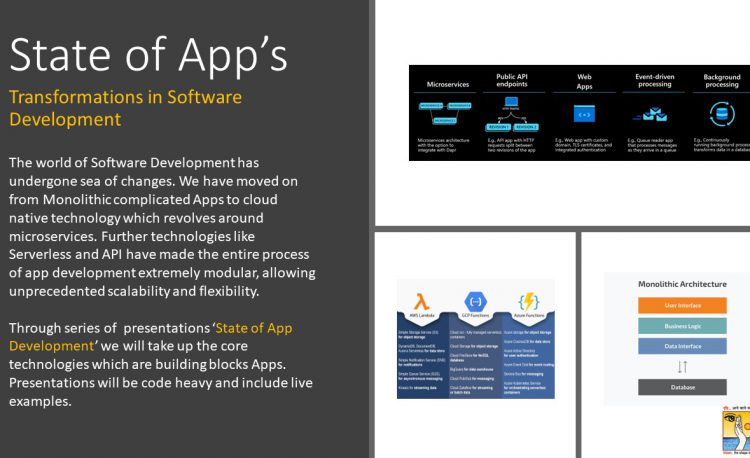- Monolithic Software with 3-Tier
- Microservices
- Containers: Going Cloud Native
- Event driven Serverless Architecture (Cloud Functions)
- Application Programming Interface (API)
- Adding AI -Building Cognitive Abilities
- 10 Technologies of the future
Transformations in Software Development
The world of Software Development has undergone sea of changes. We have moved on from Monolithic complicated Software to cloud native technology which revolves around microservices. Approaches like Serverless and API integration have made the entire process of app development extremely modular, allowing unprecedented scalability and flexibility. We have moved on from Software to App, from Servers to Cloud, and from Database to Unstructured NoSQL Data. We are witnessing unprecedented changes as we enter the age of ubiquitous computing, developed on foundation of cloud, ably supported by of Artificial Intelligence & Machine Learning, Internet of Things, Data science, Blockchain, and AR&VR.
For those related to the world of development and technology (who isn’t today?), it is essential to both understand the drivers which have called for these changes, as well as the path the technology is following. Vision Group of Institutions has adopted a systematic approach to allow our students and staff to
Monolithic Software with Traditional 3-tier application architecture
Monolith is a fully functional application bundled into a single package and is deployed as a single unit. Initially a typical software has a universally accepted 3-Tier approach including the Frontend or UI Layer, the Middle Tier or Business Logic Layer and the Backend or Data Access Layer. As software grew more complicated, few developers started using different terms for layers like Persistence Layer, Business Logic, Data Interface, Server Management, etc. However for most it remained as Traditional 3-tier application architecture.
Issues of Traditional 3-tier application architecture
Simply speaking, the 3-tier application model is outdated. It was designed for application development before the proliferation of public cloud and mobile applications and has had difficulty adapting to the cloud. Over time, an application can become too large and complex to make frequent changes. It had Application instability, Application performance , Slow development , and Limited / No innovation. Not only that, but it also requires the maintenance of at least three layers of hardware and software, which can be inefficient for the business.
We must take into account the rapidly changing purpose and role of software. Soon software had become ubiquitous; reaching out to almost all industries with varied requirements. We were looking at app to answer almost all questions of the business and everyday world. Further the way we were consuming these apps was changing from fixed desktops to remote, always-on world of mobile devices. This paved way for App Modernization.
Microservices
Microservices architecture (often shortened to microservices) refers to an architectural style for developing applications. Microservices allow a large application to be separated into smaller independent parts, with each part having its own realm of responsibility. To serve a single user request, a microservices-based application can call on many internal microservices to compose its response.
- Microservices are small, independent, and loosely coupled. A single small team of developers can write and maintain a service.
- Each service is a separate codebase, which can be managed by a small development team.
- Services can be deployed independently. A team can update an existing service without rebuilding and redeploying the entire application.
- Services are responsible for persisting their own data or external state. This differs from the traditional model, where a separate data layer handles data persistence.
- Services communicate with each other by using well-defined APIs. Internal implementation details of each service are hidden from other services.
- Supports polyglot programming. For example, services don’t need to share the same technology stack, libraries, or frameworks.
Containers- the future of App deployment
One of the best choices for creating and running microservices application architectures is by using containers. Containers encapsulate a lightweight virtualization runtime environment for your application and allow you to move the application from the developer’s desktop all the way to production deployment. You can run containers on virtual machines or physical machines in the majority of available operating systems.
Many organizations use Kubernetes to manage containers and ensure that there is no downtime. Kubernetes provides container orchestration in multiple hosts and is used for container lifecycle management. You can automate deployment, auto-scale your application, and build fast and ship fast using Kubernetes.
Event-driven serverless architecture
Event-driven architecture (EDA) is based on decoupled systems that run in response to events. An event-driven architecture uses events to trigger and communicate between decoupled services. EDA has been here for a long time, but it now has more relevance in the cloud. If properly used, it can provide a significant increase in agility, cost savings, and operational benefits. The distributed serverless EDA can execute code known as functions that scale automatically in response to a REST API or an event trigger.
For the serverless model, there is no server management needed. The serverless model is also quickly scalable (so quick updates and deployment are possible) and it is stateless. Serverless computing helps developers to build powerful applications by eliminating the need to provision and manage infrastructure. In Serverless computing, cloud vendors provision, manage and scale the infrastructure as per the need.
Application Programming Interface (API)
An application programming interface, or API, enables companies to open up their applications’ data and functionality to external third-party developers and business partners, or to departments within their companies. This allows services and products to communicate with each other and leverage each other’s data and functionality through a documented interface. Programmers don’t need to know how an API is implemented; they simply use the interface to communicate with other products and services. API use has surged over the past decade, to the degree that many of the most popular web applications today would not be possible without APIs.
An API is a set of defined rules that explain how computers or applications communicate with one another. (Typically these rules are documented in an API specification). APIs sit between an application and the web server, acting as an intermediary layer that processes data transfer between systems.
Here’s how an API works:
- A client application initiates an API call to retrieve information—also known as a request. This request is processed from an application to the web server via the API’s Uniform Resource Identifier (URI) and includes a request verb, headers, and sometimes, a request body.
- After receiving a valid request, the API makes a call to the external program or web server.
- The server sends a response to the API with the requested information.
- The API transfers the data to the initial requesting application.
While the data transfer will differ depending on the web service being used, this process of requests and response all happens through an API. Whereas a graphical user interface provides humans access to an application’s data and functionality, an API provides that access to computers or other applications.
APIs offer security by design because their position as middleman facilitates the abstraction of functionality between two systems—the API endpoint decouples the consuming application from the infrastructure providing the service. API calls usually include authorization credentials to reduce the risk of attacks on the server, and an API gateway can limit access to minimize security threats. Also, during the exchange, HTTP headers, cookies, or query string parameters provide additional security layers to the data.
Adding AI -Building Cognitive Abilities
Today, developers solve problems, big and small, across every industry and organization on the planet. We need solutions which match up to these transient and rapidly evolving, solutions which allow productivity and rapid app development for all scenarios. AI offers us similar solutions which can change the very way we develop apps and write code. Have a look at few revolutionary developments.

